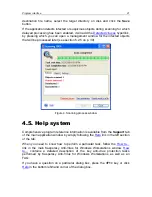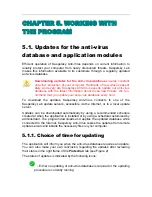
32 Kaspersky
Anti-Virus
®
5.0 for Windows Workstations
Note that scanning and disinfection of password-protected objects in
archives are NOT PERFORMED in the delayed treatment mode.
In this dialog box, you can see a list of infected and suspicious objects found
during the scan (see Figure 10). The
Object
column contains the path and the
name of each object, the
Status
column its status, and the
Recommended
action
column shows the action recommended by Kaspersky Lab experts for the
object.
In order to select an object and perform a certain action on it, you should check
its box. You can select several listed objects at once. All the objects in the list
can be selected by checking the box in the list header.
You can apply one of the following actions to the listed files:
•
Perform the recommended action
– Apply the action recommended by
Kaspersky Lab experts. The recommended action for infected objects is
disinfect
or
delete
and the action for suspicious objects is
quarantine
.
•
Delete
– Delete a file.
After an action is applied, the program will open a dialog box displaying the
action in progress. You can always stop the action by clicking
Stop
.
Processed objects will be deleted from the list. After all listed objects have been
processed, click
Close
.
5.2.6. How to scan a CD or a floppy disk
Your computer can easily be infected by viruses on floppy disks, CDs, and other
removable media. If you have used a floppy disk (or a bootable CD) infected with
a boot virus, or have left it in your floppy drive and rebooted, this may cause
serious problems with your system.
We recommend that you scan all removable media before using them.
You can scan removable media either from the Kaspersky Anti-Virus main
window or by using the Windows shortcut menu, accessed from
Explorer
,
Desktop
, etc.
To scan removable media for viruses from the Windows shortcut menu,
select the medium (you can select a CD and a floppy disk at the same
time) and click your right mouse button. The Windows shortcut menu
will appear. In this menu, select
Scan for viruses
(see Figure 6).
















































